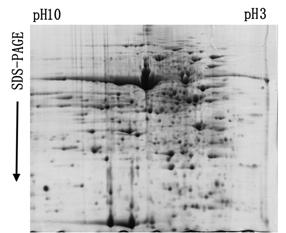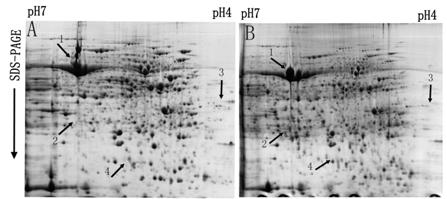Two-dimensional electrophoresis method for separating protein from kenaf leaf efficiently and stably
A two-dimensional electrophoresis and protein technology, applied in the field of plant molecular biology, can solve the problem of late start of kenaf proteomics research, and achieve the effects of stable experimental results, large numbers and uniform distribution.
- Summary
- Abstract
- Description
- Claims
- Application Information
AI Technical Summary
Problems solved by technology
Method used
Image
Examples
preparation example Construction
[0018] (1) Preparation of protein samples
[0019] Extraction of kenaf leaf protein by TCA-acetone method: Take 1g of fresh kenaf leaves (the raw material of kenaf is kenaf variety Fuhong 952), add appropriate amount of PVP, grind with liquid nitrogen for 45min, add 10mL-20℃ pre-cooled Contain 0.07% β-mercaptoethanol, 10% TCA in acetone solution, grind at low temperature for 15 minutes, and stand overnight at -20°C. Centrifuge (15000r / min, 4°C) for 15min, discard the supernatant, add 10mL of cold acetone (containing 0.07% β-mercaptoethanol) to shake, and precipitate at -20°C for 2 hours. Wash twice with -20°C pre-cooled acetone containing 0.07% β-mercaptoethanol, and vacuum-dry the precipitate to a dry powder.
[0020] Extraction of kenaf leaf protein by urea-thiourea method: take 1g of fresh kenaf leaves, add appropriate amount of PVP, grind with liquid nitrogen for 45min, add 6ml extraction buffer (40mmol / LTris-base, 5mol / LUrea, 2mol / Lthiourea, 2mol / Lthiourea, % CHAPS, 5% ...
Embodiment 1
[0034] (1) Extract kenaf leaf protein by TCA-acetone method:.
[0035] (2) Using bovine serum albumin as the standard protein, the protein content in the prepared samples was determined by Brafford method.
[0036] (3) Two-dimensional electrophoresis was carried out using 24 cm IPG strips with a pH value of 4-7, an active loading method, a loading volume of 1.4 mg, and a separation gel with a concentration of 12%.
[0037] (4) Fix for 2 hours, stain with Coomassie Brilliant Blue G250 staining solution overnight, decolorize with distilled water, scan, and analyze with software.
Embodiment 2
[0039] (1) Extract kenaf leaf protein by urea-thiourea method: Take 1g of fresh kenaf leaves, add appropriate amount of PVP, grind with liquid nitrogen for 45min, add 6ml extraction buffer (40mmol / LTris-base, 5mol / LUrea, 2mol / Lthiourea, 2% CHAPS, 5% PVP, 2% β-mercaptoethanol) low temperature grinding for 15min. Centrifuge (15000r / min, 4°C) for 15min, take the supernatant, add pre-cooled acetone containing 0.07% β-mercaptoethanol, and let stand overnight at -20°C. Wash twice with 0.07% β-mercaptoethanol, and vacuum-dry the precipitate to dry powder.
[0040] (2) Using bovine serum albumin as the standard protein, the protein content in the prepared samples was determined by Brafford method.
[0041] (3) Two-dimensional electrophoresis was carried out using 24 cm IPG strips with a pH value of 4-7, an active loading method, a loading volume of 1.4 mg, and a separation gel with a concentration of 12%.
[0042] (4) Fix for 2 hours, stain with Coomassie Brilliant Blue G250 staini...
PUM
 Login to View More
Login to View More Abstract
Description
Claims
Application Information
 Login to View More
Login to View More - R&D
- Intellectual Property
- Life Sciences
- Materials
- Tech Scout
- Unparalleled Data Quality
- Higher Quality Content
- 60% Fewer Hallucinations
Browse by: Latest US Patents, China's latest patents, Technical Efficacy Thesaurus, Application Domain, Technology Topic, Popular Technical Reports.
© 2025 PatSnap. All rights reserved.Legal|Privacy policy|Modern Slavery Act Transparency Statement|Sitemap|About US| Contact US: help@patsnap.com



